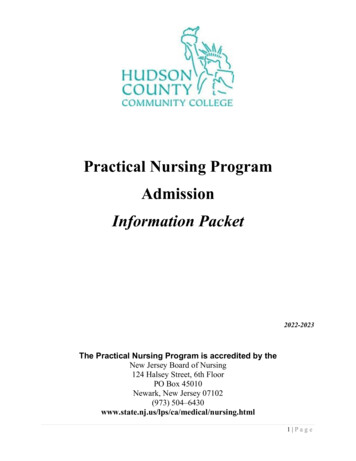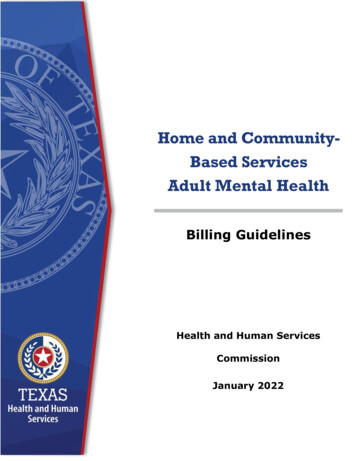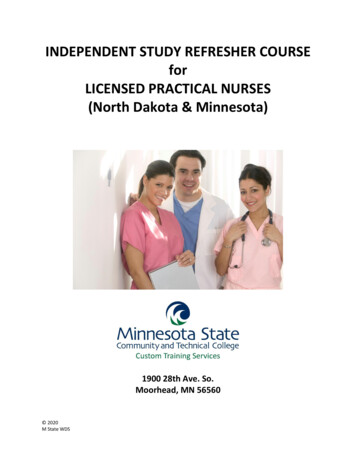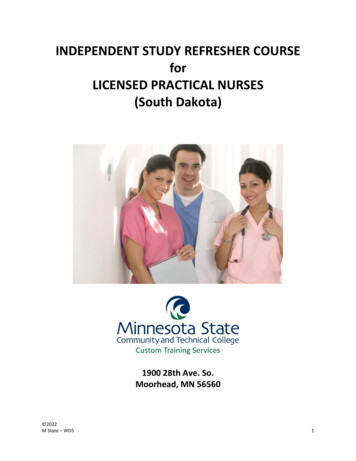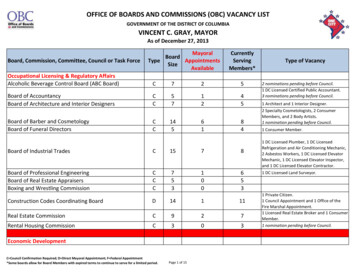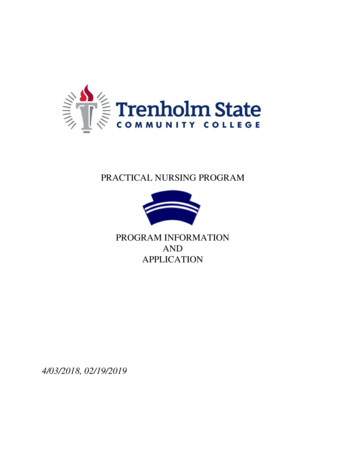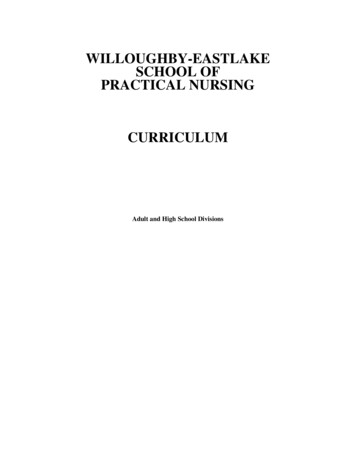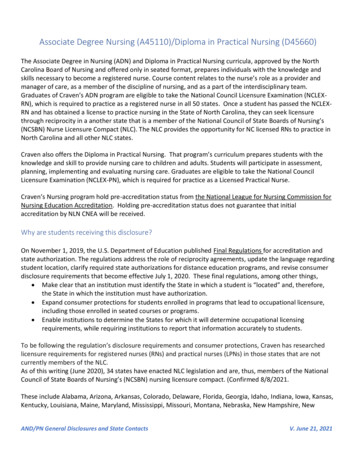
Transcription
Licensed Practical NursingProgram ProposalPresented to the South DakotaState Board of EducationNovember 2015For ImplementationFall 2016Mitchell Technical Institute1800 E. Spruce St. Mitchell, SD 57301
Mitchell Technical InstituteProgram Proposal:Licensed Practical Nursing DiplomaLength of Program:12 monthsNumber of Students:24 per cohortProjected Start Date:Fall 2016Executive Summary:Mitchell Technical Institute is requesting approval to offer a diploma in Licensed Practical Nursing (LPN).This one-year program would not only prepare students to fulfill an immediate need in the workforce,but may also serve as a pathway to other medical careers.Students who enroll in the program will range from recent high school graduates to older individualsdesiring career advancement. Students may come from a variety of cultural, educational, and socioeconomic backgrounds.The projected job growth for LPNs is 25% nationally (Bureau of Labor Statistics) and 11.5% in SouthDakota (South Dakota Labor Market Information Center, 2012-2022). Graduates will work in hospitals,clinics, nursing homes, extended care facilities, urgent care facilities and home health care. MitchellTechnical Institute plans to work with nursing programs in South Dakota to provide upward mobilityopportunities to our students.
Identification and Description of ProgramThis proposal is for a 12-month diploma program in Practical Nursing. Two entry points, August andJanuary, would allow two cohorts per year of 24 students each to start, with the intent to grow theprogram as need and interest dictates. This program will provide students with theory, simulatedpractice, and clinical experience in direct and indirect patient care, medical records, and working as amember of the healthcare team.The program will include both classroom instruction and simulated and clinical practice in adult healthnursing, maternal and child health nursing, and geriatric health nursing. The Licensed Practical NursingDiploma will teach students to collect data related to a client’s physical and mental functioning,administer prescribed medications, demonstrate effective therapeutic communication, providethorough reporting and recording, prioritize and care for multiple clients with a variety of disorders,perform technical nursing skills, and understand the importance of maintaining confidentiality.The program is designed to prepare graduates to successfully complete the National Council ofLicensure Exams for Practical Nursing (NCLEX-PN) and establish a career as a LPN. Mitchell TechnicalInstitute will seek and attain approval from the South Dakota Board of Nursing for its Practical Nursingprogram.Graduates will be career-ready in a variety of capacities: Residential treatment agencies General medical and surgical hospitals Physician offices Home health care services Community care facilities for the elderlyIn addition, MTI intends to develop articulation arrangements with nursing programs in the state thatwould allow its LPN graduates to advance in their nursing careers. For example, MTI would pursue aone-plus-one agreement with Southeast Technical Institute's LPN to RN Associate of Applied Sciencedegree. Also, Dakota Wesleyan University is currently developing an LPN to BSN program to be in placeFall 2016. MTI would pursue an agreement with DWU so LPN graduates would have an option toadvance their LPN diploma towards a Bachelor of Science degree in Nursing.
Objectives and Purpose of the ProgramThe program will offer students the experience and overall education to become a successful LicensedPractical Nurse. This program will provide attention to professionalism, communication and technicalskills.As a result of completing this program, the student will be able to:1. Demonstrate effective therapeutic communication to foster interactions with patients and othermembers of the healthcare team.2. Conduct observations of clients while providing physical and psychosocial nursing care.3. Demonstrate competence of nursing skills while caring for clients.4. Administer medications safely within the scope of nursing practice.5. Provide thorough reporting and recording to assist in continuity of care for clients.6. Measure the effect of one’s own nursing actions.7. Demonstrate the ability to prioritize and care for multiple clients with a variety of disordersunder the direct supervision of the registered nurse.The Licensed Practical Nursing Program will provide students with the knowledge, skills, and values of aLPN for entry-level practice. Students will then be eligible to take the National Council of LicensureExams for Practical Nursing (NCLEX-PN).
Methods of Attaining the Objectives of the ProgramPending state approval, MTI will seek program approval from the South Dakota Board of Nursing. MTIwill also begin to develop marketing materials for the recruitment of students. MTI will hire instructorsand, with assistance from an advisory committee, will finalize course syllabi, purchase equipment andsupplies, and secure resource materials.MTI provides assurance that it possesses the resources and staff necessary to:oDevelop marketing materials and recruit studentsoRecruit and supervise qualified staffoAssess the abilities of students for good program and course placementoDevelop and administer budgetsoMake available textbooks and other instructional resourcesoEvaluate programs and staffoAssist students in finding clinical experiencesoAssist student in finding jobsoSecure input from industry through advisory committeesoMaintain membership in professional organizations and provide time and fiscalresources for professional developmentoProvide financial aid and scholarshipsoProvide services to disabled and nontraditional studentsoProvide a variety of general education coursesoProvide a typical two-year technical institute climateoAssist students with housing and provide daytime food service
Description of the Needs Based on Labor Market DemandsAccording to the U.S. Bureau of Labor Statistics’ Occupational Outlook Handbook, “Employment oflicensed practical nurses is projected to grow nationally 25 percent from 2012 to 2022, faster than theaverage for all occupations.“As the baby-boom population ages, the overall need for healthcare services is expected to increase.Licensed practical and vocational nurses will be needed in residential care facilities and in home healthenvironments to care for geriatric patients.“Growing rates of chronic conditions, such as diabetes and obesity, will lead to increased demand forlicensed practical and vocational nurses in skilled nursing and other extended care facilities. In addition,many procedures that once could be done only in hospitals are now being done outside of hospitals,creating demand in other settings, such as outpatient care centers.“A large number of licensed practical and licensed vocational nurses are expected to retire over thecoming decade, creating potential job openings. Job prospects should also be favorable for LPNs andLVNs, who are willing to work in rural and medically underserved areas. ” cal-and-licensed-vocational-nurses.htm)The employment outlook in South Dakota is also strong:SOCCode2012Occupational Title2022Numeric PercentEmployment Employment Change ChangeLicensed Practical and Licensed29-2061Vocational Nurses2,1352,38024511.5%Source: https://dlr.sd.gov/lmic/occupation projections 2012 2022.aspxA SDWORKS! search on the South Dakota Department of Labor and Regulation website found 49healthcare facilities in South Dakota with current job openings for licensed practical nurses (October2015). Clearly, there are jobs for certified LPNs.Finally, licensed practical nursing is one of the Build Dakota priority areas as determined by theScholarship Administration Board and supported by the SD Department of Labor and Regulation, theGovernor's Office of Economic Development, the Governor's Office, and the SD Department ofEducation.Population ServedThe program is available to any applicant who has successfully completed the admission requirementsset by Mitchell Technical Institute. No prior experience in healthcare will be required. MTI does notdiscriminate in its educational programs on basis of race, color, creed, religion, age, sex, disability,national origin or ancestry. The program will draw its students from South Dakota and surroundingstates, and the opportunities for employment will favor that same geographical area. This program willbe appealing to traditional-age college students, older adults seeking career changes, and current healthcare workers who are looking to change or enhance their skills.
Projected Three-Year BudgetIf this program proposal is approved, MTI would immediately seek to hire a program director and beginmarketing the program and would thus incur salary and marketing costs in the current fiscal year asshown. The full cost would not begin until 2016-2017 when the program would be fully staffed andequipment and supplies would need to be purchased; the projected budget for the first three full yearsof the program is etingTOTAL2015-20162016-20172017-20182018-2019 40,000 155,000 158,000 162,000 0 15,000 5,000 5,000 0 5,000 5,000 5,000 2,000 2,000 2,000 2,000 2,500 2,500 2,500 2,500 44,500 179,500 172,500 176,500Program Competencies and Entry and Exit PointsInitial entry point will be the fall of 2016. The exit point will be at the completion of coursework,typically 12 months after enrollment. MTI's intent is to create an additional January entry point after thefirst full year of the program; cohorts would then enter the program each fall and spring semester andwould graduate in August and December, respectively.Graduates will receive a Diploma in Licensed Practical Nursing. Students must maintain an overall GPAof 2.0 to graduate.The curriculum is competency-based and will be reviewed and approved by a program advisorycommittee. Additionally, MTI will adhere to any future guidelines or certifications set by the industry.
Statement of Non-duplicationMitchell Technical Institute is aware that this is a duplicated program. Practical nursing programs areoffered at all three of the other technical institutes, as well as at Mount Marty College, Sinte GleskaUniversity, and Sisseton Wahpeton College, and approximately 200 LPN graduates are produced in thestate each year at these institutions. However, many of these graduates immediately go on to furthertheir education (30% of graduates at the technical institutes) and do not enter the workforce as LPNs.Those graduates who do seek employment are consistently finding jobs in the field demonstrating astrong job market in South Dakota for LPNs. The 2014 TI Placement Report showed 97% of employedLPN graduates were working in healthcare.It is worth noting also that there are no LPN programs in central South Dakota which is the region thatMitchell Technical Institute serves. Furthermore, Dakota Wesleyan University has discontinued itsAssociate Degree nursing program, which means there are no nursing programs other than four-yearprograms readily available to residents in this region of the state. The growing need for LPNs is welldocumented, and therefore Mitchell Technical Institute has asked for and received approval from thepresidents of the other technical institutes in the state to offer the Licensed Practical Nurse program.
Proposed Curriculum DesignMTI will design the curriculum to meet the following requirements of the South Dakota Board of NursingProcedure Manual for the Approval of New Licensed Practical Nursing Education Programs.Practical nurse education curriculum. The curriculum for programs preparing for practical nurselicensure shall include:(1) Concepts in biological and physical sciences:(a) Anatomy and physiology;(b) Microbiology;(c) Nutrition and diet therapy; and(d) Pharmacology;(2) Concepts in behavioral science:(a) Interpersonal relations;(b) Communication; and(c) Cultural diversity;(3) Nursing theory and clinical instruction of basic nursing concepts to enable the student todevelop competence at the entry level as a practical nurse in each of the following areas:(a) Adult health nursing;(b) Maternal child health nursing;(c) Geriatric nursing;(d) Basic concepts of clinical judgment (the nursing process);(e) Scope of practice for LPNs;(f) Legal and ethical basis of nursing practice;(g) Nursing history; and(h) Trends in nursing and healthcare delivery;(4) Knowledge of technology used in nursing practice and special health care problems.The program's curriculum will incorporate a blend of didactic and clinical instruction and will bestructured so as to provide for progression in the students' knowledge, skills, and attitudes. MTI'smedical simulation lab will be an integral part of the curriculum; it will provide practical experience in asafe, monitored environment prior to clinical practice in a hospital or other medical setting. The lab,which features high-fidelity maternal, adult, and child mannequins in a simulated examination roomenvironment, will allow students tangible, hands-on practice in nursing care. Students will completethree clinical rotations of a minimum of 120 hours each where students will practice and demonstratecompetence in entry level nursing skills.
Program CurriculumFIRST SEMESTER (Fall)SOC110Industrial Relations3 creditsMA103Anatomy and Physiology4 creditsMA162Medical Law & Ethics2 creditsLPN101Introduction to Nursing4 creditsSSS100Student Success1 creditMath Elective3 creditsBasic First Aid & CPR0.5 creditsMATHCPR100Total Semester Credits: 17.5SECOND SEMESTER (Spring)LPN103Pharmacology3 creditsLPN105Adult Health Nursing3 creditsLPN106Adult Health Nursing Clinical3 creditsLPN107Maternal & Child Nursing3 creditsLPN108Maternal & Child Nursing Clinical3 creditsCIS105Complete Computer Concepts3 creditsTotal Semester Credits: 18.0THIRD SEMESTER (Summer)LPN110Trends in Nursing3 creditsLPN111Geriatric Nursing3 creditsLPN112Geriatric Nursing Clinical3 creditsEnglish Elective3 creditsTotal Semester Credits: 12.0
National Wage FactorIn May 2012, the median annual wage for licensed practical nurses was 41,540. The median wage is thewage at which half the workers in an occupation earned more than that amount and half earned less.Most licensed practical nurses are employed fulltime, although about 1 in 5 worked part-time in 2012.Many work nights, weekends, and holidays because medical care takes place at all hours. Many will berequired to work shifts longer than 8 hours.Source: U.S. Bureau of Labor Statistics, Occupational Outlook 5South Dakota Wage FactorThe average hourly wage for Licensed Practical Nurses in South Dakota is 17.28, according to the SouthDakota Labor Market Information Center’s June 2015 estimates. The wage at the 25th percentile is 15.12, which would be an estimate of the starting salary graduates could expect. (The average startingwage reported on the TI Placement Report for LPN graduates was 15.21.) Experienced LPNs in SouthDakota make over 22.00 per hour.In addition, graduates who continue their education in nursing can increase their earning potentialsignificantly. Registered nurses in South Dakota earn an average hourly wage of 26.48 ( 35.71 for the90th percentile).Source: SD Labor Market Information Center ASP); 2014 South DakotaTI Placement ReportCIP Code51.3901 Licensed Practical NurseDuties of LPNs vary depending on their work setting and the state in which they work. For example, theymay reinforce teaching done by registered nurses regarding how family members should care for arelative; help to deliver, care for, and feed infants; collect samples for testing and do routine laboratorytests; or feed patients who need help eating.LPNs may be limited to doing certain tasks, depending on their state. For example, in some states, LPNswith proper training can give medication or start intravenous (IV) drips, while in other states LPNscannot perform these tasks. State regulations also govern the extent to which LPNs and LVNs must bedirectly supervised. For example, an LPN may provide certain forms of care only with instructions from aregistered nurse.
APPENDIX
Matt Ditmanson2100 Highland Way Ste. KMitchell, SD 57301August 25, 2015Mr. Mark Wilson, PresidentMitchell Technical InstituteMitchell, SD 57301Mr. Wilson;I am writing to offer support for Mitchell Technical Institute’s proposed new LPN program. Ourevolving health care delivery model (Patient Centered Medical Home) is a team concept andincludes a LPN working as primary nurse support for physicians.I have hired three LPN’s in the past year and know my colleagues at Sanford Health agree thathaving locally trained LPN staffing is a great benefit. Specifically in Mitchell, we can help supportMTI’s program with mentoring, class presentations and internships (locally or throughout SanfordClinics).Again, we fully support your program development and hope the South Dakota Department ofEducation, Board of Nursing and others see the wonderful opportunities this program willprovide.Best regards,Matt DitmansonMatt DitmansonDirector of Clinic Operations
would allow its LPN graduates to advance in their nursing careers. For example, MTI would pursue a one-plus-one agreement with Southeast Technical Institute's LPN to RN Associate of Applied Science degree. Also, Dakota Wesleyan University is currently developing an LPN to BSN program to be in place Fall 2016.
